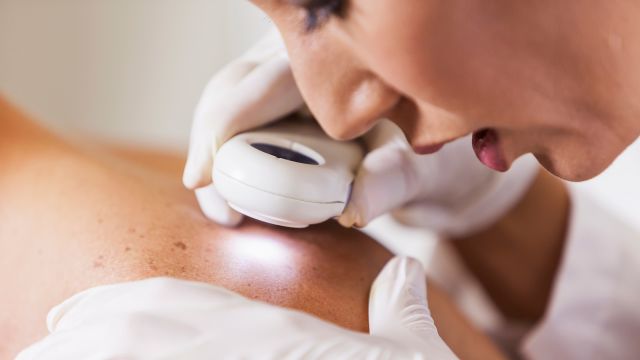Skin cancer is the most common type of cancer in the United States and the most treatable, if caught early. There are several types of skin cancer. We talked to dermatologist James DeVito, MD, of Sky Ridge Medical Center in Lone Tree, Colorado, to get the facts about skin cancer.
Types and symptoms
- Basal cell carcinoma: The most common type of skin cancer, basal cell carcinoma (BCC) usually looks like pearly, shiny bumps. According to the American Cancer Society, roughly 8 out of 10 skin cancers are basal cell carcinomas.
- Squamous cell carcinoma: Squamous cell carcinomas (SCC) are the second most common type of skin cancer. They’re usually rough and crusty and may look like a bug bite or pimple.
- Melanoma: This type of cancer causes only about one percent of skin cancers but it is the most deadly, responsible for the majority of skin cancer deaths. It’s usually brownish in color and looks like a mole, often with irregular borders. “Melanoma has the tendency to spread throughout the body. That’s why it’s so deadly,” explains Dr. DeVito.
Actinic keratoses are dry, scaly patches that are considered precancerous. If left untreated, they may become SCC.
Risk factors
“We know that all of these cancers occur by ultraviolet exposure, and there’s clearly a genetic risk factor,” says DeVito. Natural sunlight and tanning beds both increase the risk of skin cancer. In addition, if you have fair skin, red or blonde hair, blue or green eyes or have irregular moles, you may be at increased risk of skin cancer, as is anyone who sunburns easily or had blistering sunburns as a child or teen. Having a family history of melanoma also increases your risk of skin cancer.
Diagnosis
“Most of the time, we can diagnose skin cancer clinically, pretty much by looking at it,” says DeVito. But, doctors will perform a biopsy to find out for sure if the mark or lesion is cancerous.
If you notice a suspicious looking mark or mole on your skin, see your doctor. “We want patients to be on the lookout for moles that look different,” says DeVito.
Follow the ABCDEs at home to check yourself for melanoma: asymmetry, irregular borders, a variety of colors, a larger diameter, and evolution over time (does it change?)
Prevention
Limit sun exposure and avoid tanning beds. When you’re outside, use a physical sunscreen—that’s one that has either zinc oxide or titanium dioxide—of at least SPF 30, which can help protect again 97 percent of the sun’s rays. “I prefer 45,” DeVito says. “When the numbers get higher than 45 I don’t think they make much of a difference.” And, get annual mole checks, either by your primary care provider or dermatologist.
Treatment
Most skin cancer is surgically treated, says DeVito. BCC and SCC are sometimes burned off if it’s small enough, and topical treatments are available as well. In addition, SCC may be treated by freezing, phototherapy or laser therapy. After surgery, melanoma may be followed up with radiation or chemotherapy.


